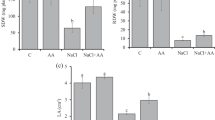Abstract
There was a large increase in nitrate reductase activity (NAR) assayed both in vivo and in vitro in roots of barley plants (cv. Midas_ grown with roots at 10°C and shoots at 20°C, compared with whole plants grown at 20°C. There were diurnal fluctuations in NRA in roots from both treatments, but they were much greater in roots grown at 20°C, where NRA fell to a very low value in the dark period. The diurnal fluctuations in the malate content of the roots were also related to the root growth temperature. Plants with roots grown at the lower temperature had a higher malate content, especially in the dark period where it was 20 times greater than in plants with roots at 20°C. At all times there was a three-fold increase in soluble carbohydrate in cooled roots and diurnal fluctuations were much less pronounced than those of malate. Growth at low temperatures increased the total flux of amino N into the xylem sap and increased the proportion of reduced N in the total N flux. At certain times of day both 10°C- and 20°C-grown roots responded to exogeneous malate by increasing the flux of amino acid into the xylem sap, although this effect was always more pronounced in 20°C-grown roots.
Similar content being viewed by others
Abbreviations
- NR(A):
-
nitrate reductase (activity)
- MDH:
-
malate dehydrogenase
- PEP:
-
phosphoenol pyruvate
References
Beevers, L., Hageman, R.H.: The role of light in nitrate metabolism in higher plants. Photophysiol.7, 85–113 (1972)
Ben Zioni, A.: Nitrate uptake by roots as regulated by nitrate reduction products of the shoots. Physiol. Plant.24, 288–290 (1971)
Ben Zioni, A., Heimer, Y.M.: Temperature effect on nitrate reductase activity in vivo. Plant Sci. Lett.9, 225–231 (1977)
Brewer, P.G., Riley, J.P.: Automatic determination of nitrate in seawater. Deepsea Res. Oceanog. Abstr.12 (6), 765–772 (1965)
Butz, R.G., Jackson, W.A.: A mechanism for nitrate transport and reduction: a review. Phytochemistry16, 409–417 (1977)
Chantarotwong, W., Huffaker, R.C., Miller, B.L., Granstedt, R.C.: In vivo nitrate reduction in relation to nitrate uptake, nitrate content and in vitro nitrate reductase activity in intact barley seedlings. Plant Physiol.57, 519–522 (1976)
Clarkson, D.T.: The influence of temperature on the exudation of oxylem sap from detached root systems of rye (Secale cereale) and barley (Hordum vulgare). Planta132, 297–304 (1976)
Clarkson, D.T., Hall, K.C.: Membrane lipids of roots of rye and barley in relation to cooling. A.R.C. Letcombe Lab. Report 1976, 18–21, 1977
Clarkson, D.T., Shone, M.G.T., Wood, A.V.: The effect of pre-treatment temperature on the exudation of xylem sap by detached barley root systems. Planta121, 81–92 (1974)
Clement, C.R., Hopper, M.J., Jones, L.H.P., Leafe, E.L.: The uptake of nitrate byLolium perenne from flowing nutrient solution. Effect of light, defoliation and relationship to CO2 flux. J. Exp. Bot.29, 1173–1184 (1978)
Davies, D.D.: Control of and by pH. Symp. Soc. Exp. Biol.27, 513–529 (1973)
Deane-Drummond, C.E., Clarkson, D.T., Johnson, C.B.: The effect of shoot removal and malate on the activity of nitrate reductase assayed “in vivo” in barley roots (Hordeum vulgare cv Midas). Plant Physiol.64, 660–662 (1979)
Doddema, H., Otten, H.: Uptake of nitrate by mutants ofArabidopsis thaliana, disturbed in uptake or reduction of nitrate III. Regulation. Physiol. Plant.45, 339–346 (1976)
Fairbairn, N.J.: A modified anthrone reagent. Chemy. Ind72, 86 (1953)
Lips, S.H., Beevers, L.: Compartmentation of organic acids in corn roots. I. Differential labelling of 2 malate pools. Plant Physiol.41, 709–712 (1966)
Magalhaes, A.C., Peters, D.B., Hageman, R.H.: Influence of temperature on nitrate metabolism and leaf expansion in soybean (Glycine Max L. Merr.) seedlings. Plant Physiol.58, 12–16 (1976)
Moorby, J., Troughton, J.H., Currie, B.G.: Investigations of carbon transport in plants. II. The effects of light and darkness and sink activity on translocation. J. Exp. Bot.25, 937–944 (1974)
Neyra, C.A., Hageman, R.H.: Pathways for nitrate assimilation in corn (Zea mays L.) leaves. Plant Physiol.62, 618–621 (1978)
Nicholas, J.C., Harper, J.E., Hageman, R.H.: Nitrate reductase activity in soybean (Glycine max). Effects of light and temperature. Plant Physiol.58, 731–735 (1976)
Onweueme, I.C., Laude, H.M., Huffaker, R.C.: Nitrate reductase activity in relation to heat stress in barley seedlings. Crop Sci.11, 195–200 (1971)
Pate, J.S.: Uptake, assimilation and export of nitrogen by the root. J. Soil Sci. Biochem.5, 109–119 (1973)
Radin, J.W.: Contribution of the root system to nitrate assimilation in whole cotton plants. Aust. J. Plant Physiol.4, 811–819 (1977)
Radin, J.W., Parker, L.L., Sell, C.R.: Partitioning of sugar between growth and nitrate reduction in cotton roots. Plant Physiol.62, 550–553 (1978)
Raven, J.A., Smith, F.A.: Nitrogen assimilation and transport in vascular land plants in relation to intracellular pH regulation. New Phytol.76, 415–431 (1976)
Ting, I.P., Führ, I., Curry, R., Zschoche, W.C.: Malate dehydrogenase enzymes in plants. Preparation, properties and biological significance. In: Isozymes. II. Physiological function, pp. 369–384. Markert, C.L., ed. New York, San Francisco, London: Academic Press 1975
Wallace, W., Pate, J.S.: Nitrate reductase in the field pea (Pisum arvense L.). Ann. Bot.29, 655–671 (1965)
Williamson, J.R., Corkley, R.E.: Assays of intermediates of the citric acid cycle and related compounds by fluorometric enzyme methods. In: Methods Enzymol, vol. XIII, pp. 434–513, Lowenstein, J.M., ed. New York, London: Academic Press 1969
Wylie, E.B., Johnson, M.J.: Effect of penicillin on the cell wall ofEscherichia coli. Biochim. Biophys. Acta59, 450–457 (1962)
Younis, M.A., Pauli, A.W., Mitchell, H.L., Stickler, F.C.: Temperature and its interaction with light and moisture in nitrogen metabolism of corn (Zea mays) seedlings. Crop Sci.5, 321–326 (1965)
Author information
Authors and Affiliations
Rights and permissions
About this article
Cite this article
Deane-Drummond, C.E., Clarkson, D.T. & Johnson, C.B. The effect of differential root and shoot temperature on the nitrate reductase activity, assayed in vivo and in vitro in roots ofHordeum vulgare (barley). Planta 148, 455–461 (1980). https://doi.org/10.1007/BF02395315
Received:
Accepted:
Issue Date:
DOI: https://doi.org/10.1007/BF02395315




